This post may contain affiliate links. Please read my disclosure and privacy policy.
This Almond Milk recipe is an easy dairy-free alternative that tastes even better than the store-bought variety. All you need is 2 ingredients to get started!

Why You’ll Love It
It tastes amazing. Homemade almond milk tastes far superior when compared to store-bought almond milk, so be warned– you may never want to buy the prepared version again.
It’s easy to make. Just blend almonds and water together in a blender, then strain out the pulp. The entire process can be done in just 5 minutes, minus the time it takes to soak the almonds. (Soaking is optional, though!)
It’s made without preservatives or thickeners. Store-bought milks need to rely on preservatives for a long shelf life, and often add gums and thickeners to make the milk have a uniform consistency. When you make almond milk at home, you can skip those added ingredients.
It’s easy to customize. You can easily add extra flavor to this almond milk recipe, like vanilla or chocolate, depending on your preference. Check out my Vanilla Almond Milk and Chocolate Almond Milk variations, if you want extra guidance.
It’s gluten-free & dairy-free. For those who can’t tolerate cow’s milk, almond milk is an easy lactose-free option. You can use it in smoothies, soups, sauces, cereal, and more!
You can use the pulp, too. Not only will you have delicious almond milk to drink, but you can also use the leftover pulp to make Almond Pulp Hummus or Almond Pulp Brownies.
Ingredients You’ll Need
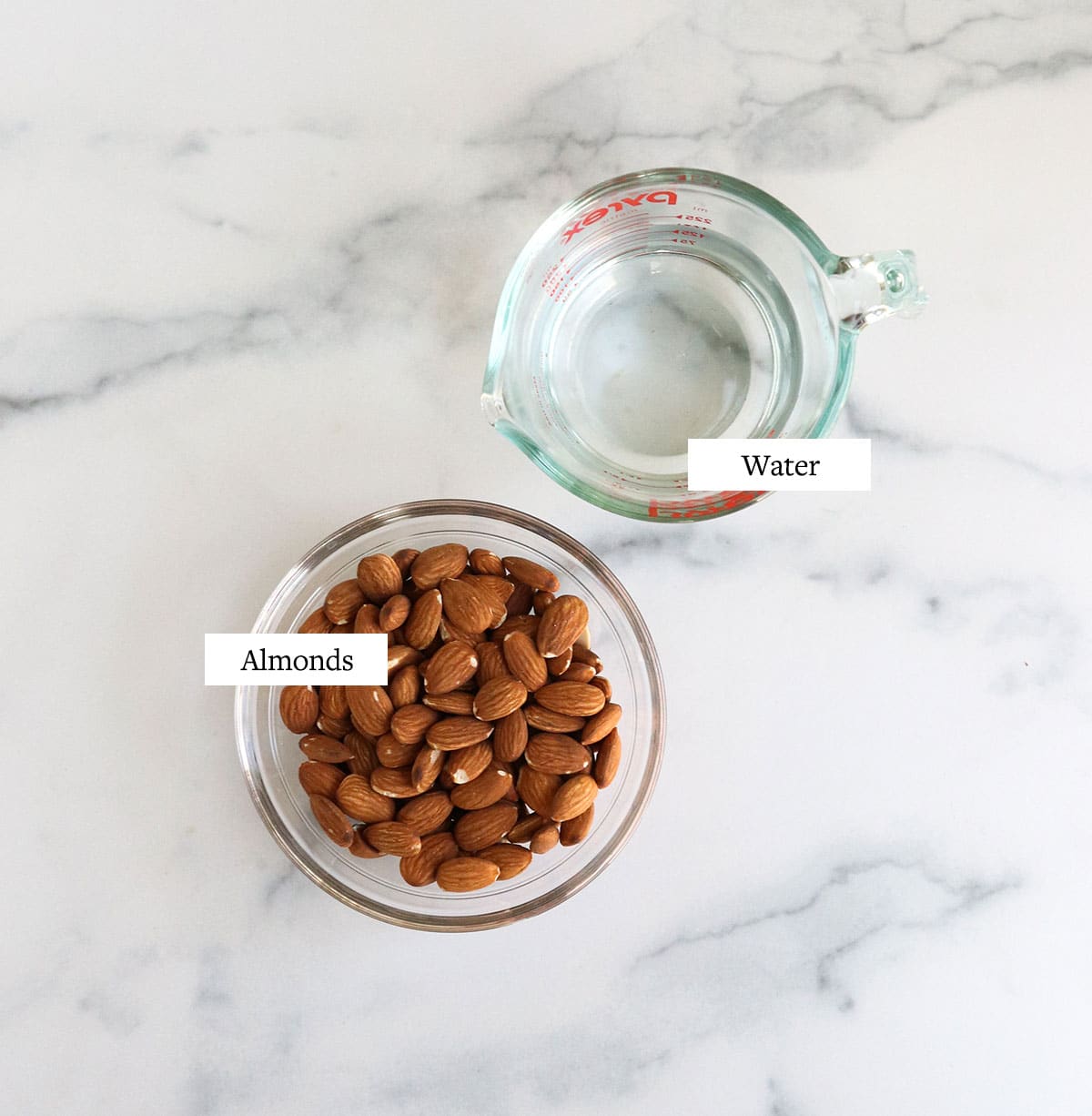
The only two ingredients you need to make almond milk are almonds and water. I tend to use almonds that are not roasted or salted, so the almond milk will have a neutral, mild flavor. However, roasted nuts will work, too!
If you want to make a flavored almond milk, you can also add in vanilla extract and a splash of maple syrup, for sweetness.
How to Make Almond Milk
1. Soak the almonds.
Research doesn’t necessarily support the idea that soaking nuts improves digestion or reduces anti-nutrients, but soaking almonds ahead of time can make them softer and help them break down in your blender easier.
If you want to take the time to do this step, cover the almonds with at least 2 inches of water, so they have room to expand as they soak. (I usually use 2 cups of water to cover 1 cup of almonds.) Let them soak for up to 8 hours, then drain away the soaking water by pouring the almonds into a fine mesh strainer.
You can skip this step if you already have a high-speed blender that can break down almonds effortlessly, or if you’re simply short on time!
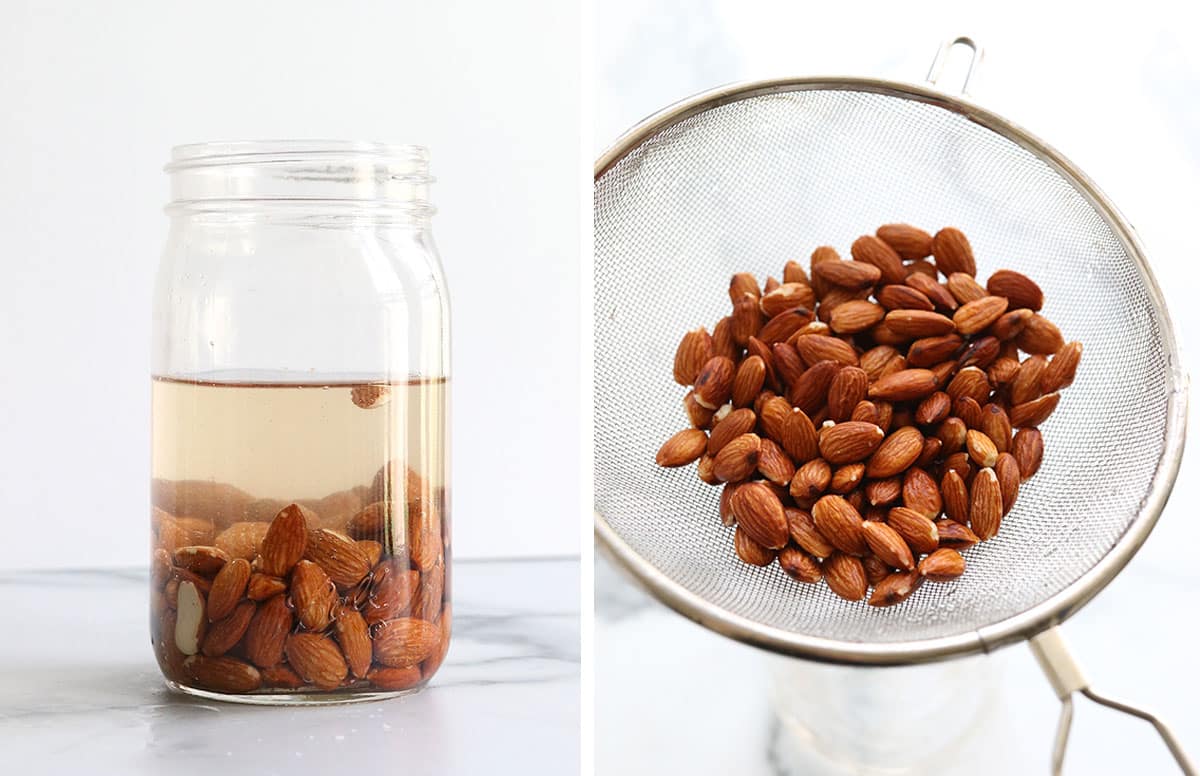
2. Blend.
Add the almonds into a high-speed blender, along with 4 cups of fresh water. Secure the blender’s lid and blend until the almonds are totally broken down and the mixture looks creamy, about 60 to 90 seconds.
There should be almost no visible almond pieces when it’s done blending.

3. Strain.
Arrange a nut milk bag or cheesecloth over a large bowl, then pour the blended almond mixture into the bag. Carefully squeeze the bag, removing as much liquid from the almond pulp as possible.
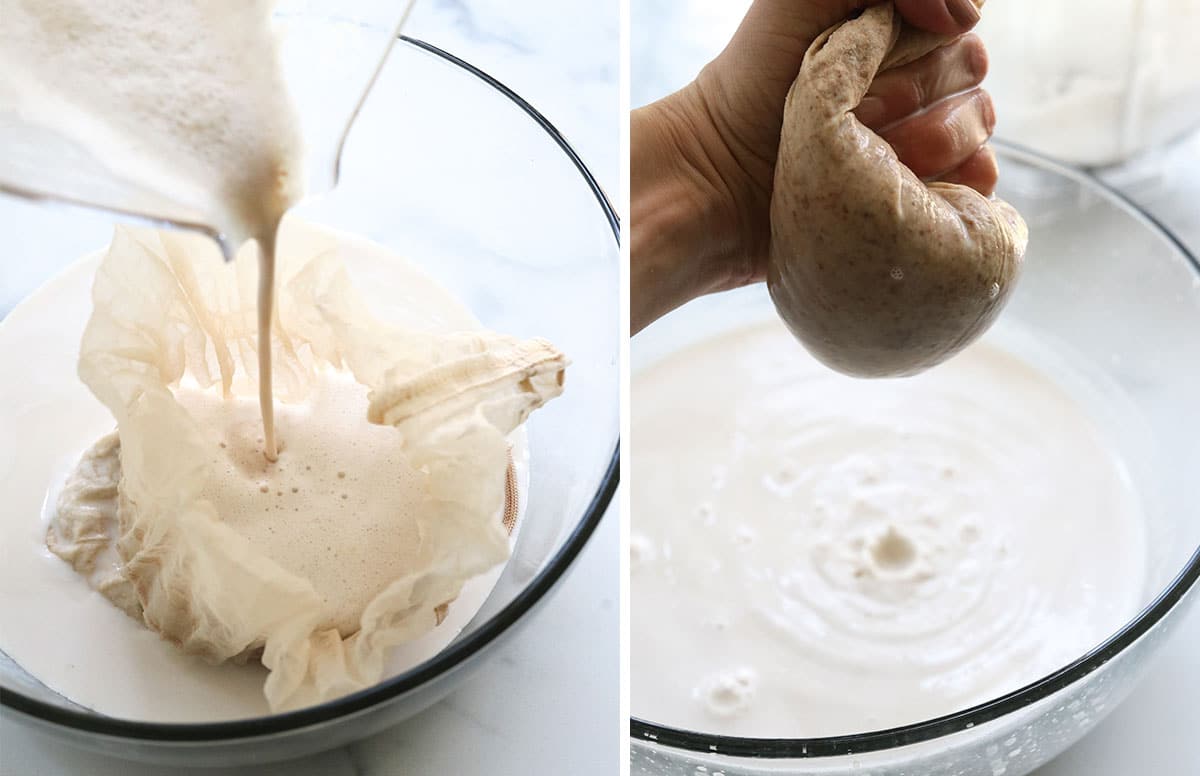
4. Enjoy!
You can use the almond milk right away, or add any extra flavorings to taste, such as vanilla, maple syrup, or a pinch of sea salt. Transfer the almond milk to an airtight container and store it in the fridge for up to 5 days. Or you can freeze it for up to 3 months.
Because this recipe doesn’t call for any preservatives, it won’t last as long as store-bought milks do. (You’ll be able to tell it’s gone off when the smell or flavor goes sour.) Be sure to make only what you’ll drink in a week, or plan on freezing the leftovers. You can easily scale the recipe as needed!
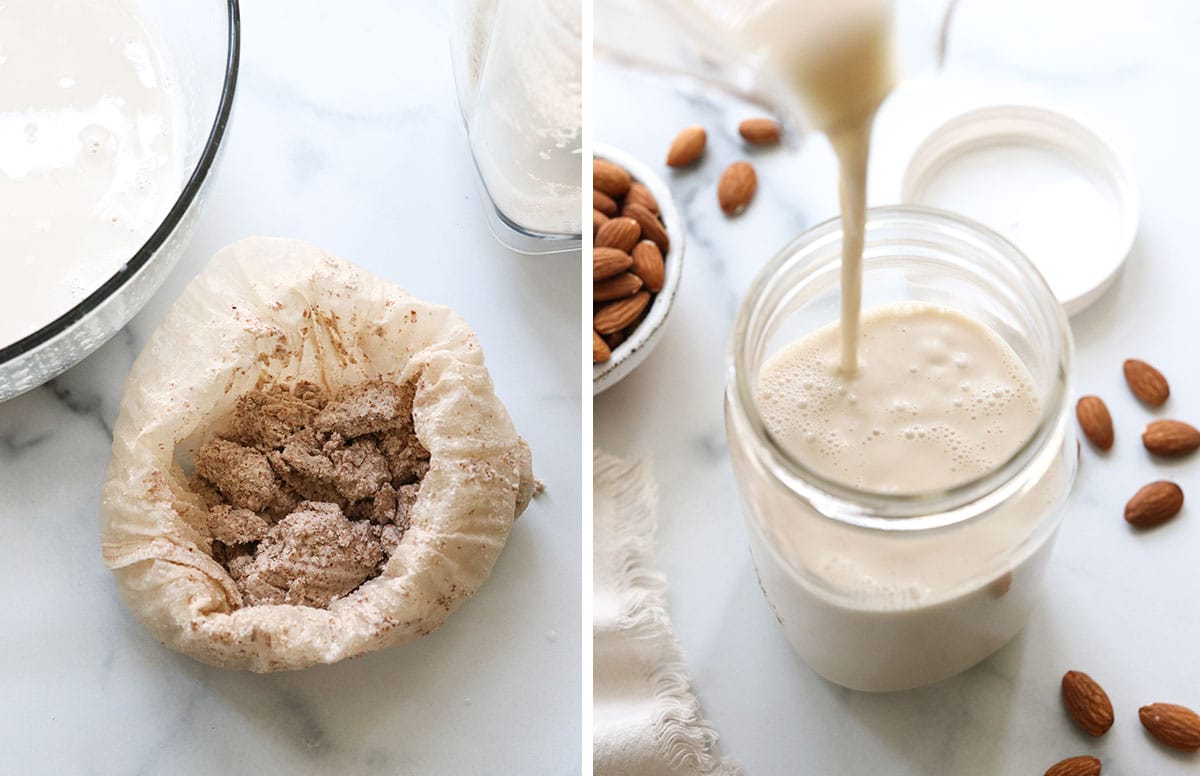
Frequently Asked Questions
Almonds contain important vitamins and minerals, like vitamin E and magnesium. Magnesium is involved in many processes in the body, including blood sugar control, so drinking almond milk may help you reach some of your nutrient needs. It’s also helpful if you are dealing with lactose intolerance, and need a dairy-free alternative.
Straining the almond milk is significantly more difficult when you add cocoa powder into the mix, so it’s best to strain the almond pulp before adding flavoring. This also keeps the almond pulp neutral-flavored, so you can use it in other recipes later (like hummus, which would not work with sweet almond pulp).
You can use the wet almond pulp immediately to make a batch of almond pulp hummus, or you can dry the almond pulp in a dehydrator or low-heat oven and save it to use a flour alternative. It’s not quite the same as almond meal, because some of the fat content has been removed, but it can also work similarly to oat flour in recipes.
Try using it in chia pudding, or over granola, or stirred into your morning oatmeal. It’s also can be frothed to make a foam for lattes, or use it in a chai latte or healthy hot chocolate.
Looking for more dairy-free milk ideas? You can make homemade oat milk for an affordable option, or try hemp milk for extra plant-based protein.
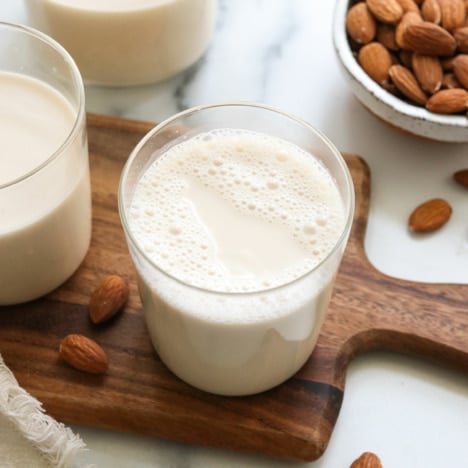
Ingredients
- 1 cup almonds
- 4 cups filtered water
Instructions
- To soak the almonds before blending, cover them with 2 cups of water in a large bowl or jar, and let them soak for 4 to 6 hours. This step is optional, but may help with blending later if you don't have a powerful blender. Drain the almonds through a fine mesh strainer before moving on to the next step.
- Add the almonds and 4 cups of fresh water to a blender. Secure the lid and blend on high-speed for at least 60 seconds, until no pieces of almonds are visible and the mixture looks creamy.
- Pour the almond milk through a nut-milk bag or cheese cloth, squeezing well to extract the milk. You can save the remaining almond pulp for another recipe (see the full post for ideas) or discard. If you would like to flavor the almond milk with vanilla or chocolate flavorings, this is the time to whisk in any additions.
- Store the almond milk in an airtight container in the fridge for up to 4 days. (You can freeze leftovers, if needed, for up to 3 months, too!)
Video
Notes
Nutrition
If you try this almond milk recipe, please leave a comment and star rating below letting me know how you like it!
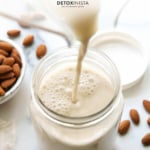

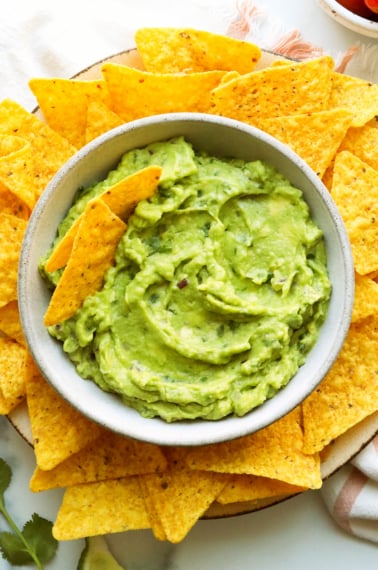
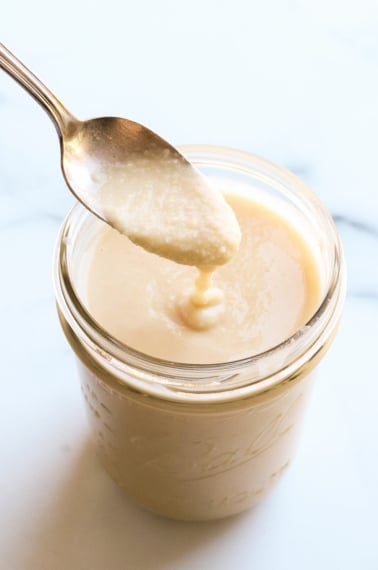
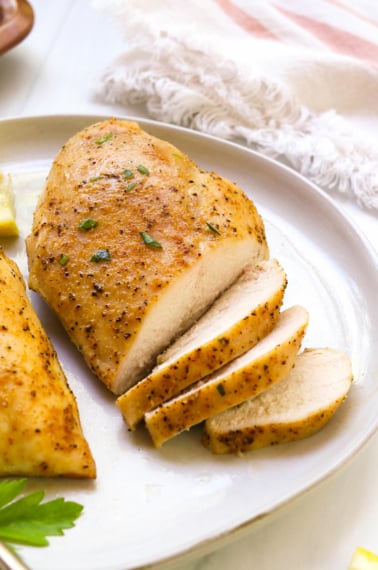







WOW….this is awesome and SO much better than the box kind….EASY…. Why the short shelf life in the fridge??
It doesn’t have the same preservatives that the boxed stuff does, so it will go bad faster. I’ve been known to use mine for a little over a week, but you will *know* when it’s bad– it will taste awful after too long!
Could I use raw honey instead of maple syrup? It may last an extra day too with honey.
Sure!
Thank you so much for this almond butter receipe. I tried making it tonight and turned out really good, then i tried honey roasted peanut butter, execelent good and nutrious and ya know whats in this stuff, next is the almond milk, but need to get more almonds. gonna share this with my friends.
I just put 3 cups of water and 2 tablespoons of almond butter (I make my own, but any will work) in the blender for a few minutes (even though I have a vitamix, because the small particles require longer blending). Then I put a fine mesh tea strainer (a coffee filter would work too) on whatever container I’m going to use and strain it through. It stays in the fridge for a few days, just like normal almond milk. If you’re not picky about the pieces you can skip straining it altogether. I bet with blanched almonds you wouldn’t even need to stain it, but I can’t find organic blanched ones, and I like that the organic ones I buy are in the bulk section (reduces waste).
Do you have a source for your organic almonds? It seems that you use a lot of them so I would think you get them in bulk somewhere. I have a large family and so making these recipes can be very expensive. Any info on a good source for organic bulk shopping would be appreciated. Thank you
Hi Paula! I’ve listed a few sources for raw & organic almonds in this post: https://detoxinista.com/2012/08/are-your-almonds-truly-raw/ You can buy them in bulk directly from one of the farms I’ve mentioned there, though shipping is still rather expensive. Lately, I’ve been using less almonds and just buying the organic, raw almonds from Trader Joe’s.
Hi, thanks for the inspiration. I am always looking for ways to make interesting, good for my family that is a healthy alternative. I figure any change is good. This almond milk recipe looks promising, will give it a try. My daughter does not like the store version, so maybe she will give this a try. Also love that you suggest but don’t force the issue of raw eating, it is more inviting to those of us that take change more slowly. Thanks Again!
Almond pulp is actually really useful if you dry it out. Either in the oven at a low temperature or in a dehydrator. If you want great almond flour (and you’re not eating completely raw) blanche the almonds to get the skins off: http://www.ehow.com/how_2081995_blanche-almonds.html
After you make the milk, dry out the pulp and grind it up in a vitamix/spice grinder/bullet. BAM…perfect almond flour to use in baking. It tastes more bitter if you leave the skins on, but then you can manage some raw-some brownie bites with the help of a dehydrator.
I used to make these all the time: http://recipes.sparkpeople.com/recipe-detail.asp?recipe=609048
<3
Thanks for sharing! I love Ani Phyo’s recipes, so I’ll have to try those cookies! 🙂
This recipe looks fascinating, but I just have a question. Should I use raw or roasted almonds? Raw almonds are my most favorite snack 🙂
Does it make a difference? And sorry if someone has stated this already; I just didn’t see it.
I don’t think it makes a huge difference, though it will effect the flavor, since roasted almonds taste different. I prefer the taste of raw almonds, so that’s what I use!
I found the almond pulp works well in hummus. Also have made a few cookies with this. Although it’s loaded with sugar, I used the Alton Brown’s Chewy Chocolate Chip recipe (my all time favorite chocolate chip cookie). Just replaced all the bread flour with almond meal. I also had to put it in a 9×13 pan and cooked it a little longer. Again, this recipe isn’t the greatest for raw foods. But I imagine a lot of the ingredients could be replaced with more raw items.
How much coconut oil do I use?
The recipe calls for 1 Tablespoon of coconut oil, but it’s completely optional. I usually make my almond milk “plain,” using just the almonds and water, but the coconut oil makes it extra-creamy!
Hey Megan, I was wondering how you can use the homemade almond milk instead of regular milk… wheres the calcium and nutritional value?
Hi Victoria! In regards to recipes, you can use almond milk as a substitute for regular milk in most situations. Personally, I don’t think we should be drinking regular milk at all, and don’t believe it to be a good source of calcium– in fact, from what I understand, calcium is actually depleted from our bones when we drink milk, due to the high protein/acidity content. (You can read more on that here: http://saveourbones.com/osteoporosis-milk-myth/) Countries with the lowest consumption of dairy products also have the lowest fracture incidence in their population.
It’s difficult to determine the exact nutritional value in homemade almond milk, but it should retain all of the nutrition found in the almonds used– one cup of almonds contain 25 % of your daily calcium, 25% vitamin D, 125% vitamin E, and 25g of protein. (Divide that by 4 servings for this recipe)
Hope that helps!
Spinach and Kale have more calcium then milk. I am with you all the way Megan. I know a woman who used almond milk her whole life because she was allergic to regular milk. She had a Bone density test and the Doctor said her bones were strong as if she was 30 years old. She’s 60.
Hi, just wondering if you have worked out the macros, carbs, protein and fat per serving of homemade almond milk? I make a litre of almond milk every 5 days or so but have started to track my macros but the almond milk is confusing me????